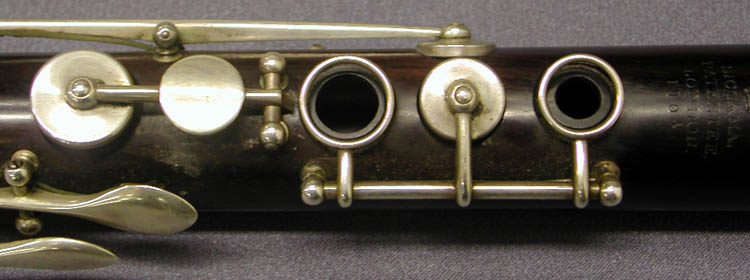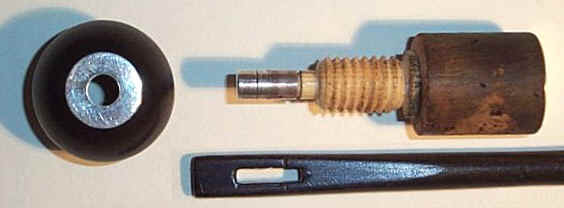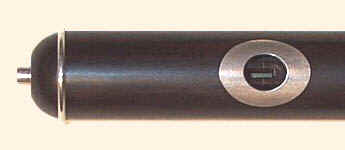Examples of Siccama Flutes
Hudson Keys
The flute below is an example of a Siccama flute with keys understood
to have been made by Hudson. The flute is fully post-mounted and
the keys are unusual in that their semi-cylindrical cups screw into a
boss at the end of the key-shaft. This is a little reminiscent of
the arrangement Monzani used, although his cups were designed to float
and thus pick up the best seat. These cups screw up hard and have
no apparent additional purpose other than to excite speculation in 21st
century flute enthusiasts (see the flute fitted with Brille below for a
closer image of the keys) . It seems likely that Siccama was
following the appearance of the keys fitted to Boehm's 1832 conical
ring-key flute.

Siccama Flute No 321, McGee Flutes
Research Collection
Block mount with saltspoon keys
While other Siccama flutes seem all to come with post-mounted "Hudson
keys", here's one with the more traditional block mounts (except on the
Siccama keys for L3 and R3) and with saltspoon-style cups.
Presumably for a customer who preferred the traditional appearance.
This image, kindly provided by David Levine, also offers us a closer
look at the pewter plugs on the lowest two holes, and the offset Short F
key fitted to Siccama flutes. On the 8-key flute, the gap between
R2 and R3 is reduced to what the hand can take, and there is just room
to squeeze in the short F key and block between them. On the
Siccama flute, the R3 key enables the holes to be where they should be.
Siccama clearly wanted that to apply to F natural as well, hence the
offset needed to operate it from where the touch has to be.

Siccama No 400, David Levine
With Brille
While relocating the open finger holes did great things for the general intonation
of the flute, c# (fingered ooo ooo) remained flat, due to inadequate
venting. Opening the c key provided the additional venting required,
but who had time for that in the middle of a torrid scherzo? The
"Brille" (German for spectacles) could fix that
automatically. In c# (ooo ooo), it opened to provide the needed
additional venting. In any other fingering, it remained closed.

Siccama Flute No 1104, Royal Northern College Of Music
We see again, in the image above, the style of key-work
ascribed to former Siccama employee, John Hudson.
A foot with card-backed pads
Eight key style flutes tended to cling to the old pewter
plugs for the lowest two or three notes. Pewter plugs would keep
their shape while pursepads were unworkable on large holes and especially
on normally-open keys. Early Siccamas used pewter plugs, but note
the foot below employs card-backed pads on all holes.

Siccama Flute No 1104, Royal Northern College Of Music
The Stopper and the Cleaning Rod
Not particularly fashionable parts of the instrument
normally, but Siccama's attention to detail is evidenced here too.
Siccama's stopper (which you can see below) is a piece of ivory which
passes right through the cork and terminates in a silver facing plate at
one end and a silver indicator rod at the other. This is handy for
us as it means that even after the cork has been replaced, the stopper
length will be the same. And this keeps the incised mark on the rod
that protrudes through the hole in the cap meaningful.

But still not enough for Siccama. Obviously of a
"belts and braces" mentality, he also puts a stopper setting
mark on the end of the cleaning stick supplied with the instrument.
As you can see, when the stopper is set so that the incised mark is flush
with the face of the cap, the mark on the cleaning rod appears central in
the embouchure hole. And this is no mere speculation, as he mentions
all of this in an addendum to his "Theory of the Patent Diatonic
Flute". Very Siccama.
| Interestingly, the mark is at 17mm,
the same as is now used for Boehm flutes and 2mm less than that
normally proposed for conical flutes. This confirms that
Siccama was opting for "best 2nd and 3rd octave performance and
tuning" rather than "best low octave performance". |
 |
The embouchure of Siccama flute #833 showing the mark on the cleaning
rod central in the embouchure. I am indebted to UK flute owner, Ray
Castell for these cleaning rod images.
More Siccamas Sought!
If you have or know of a Siccama flute
not listed here, or that appears significantly different from those
shown, do let us know! We'd like to know:
Serial Number:
Speaking length:
Body + foot length:
C#-Eb length:
Brille? <Y/N>
Key Mounts? <B/P/M>
Key type: <O/H/R/A/F>
Touches dished or domed:
Metal: <S/N>
Collection & Cat No:
(and remember, the definitions appear at the top of this
page.)
You might also be interested in seeing Siccama-style
flutes by other makers.
Back to McGee-Flutes
Home Page
|